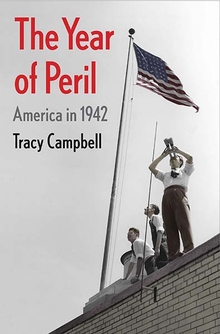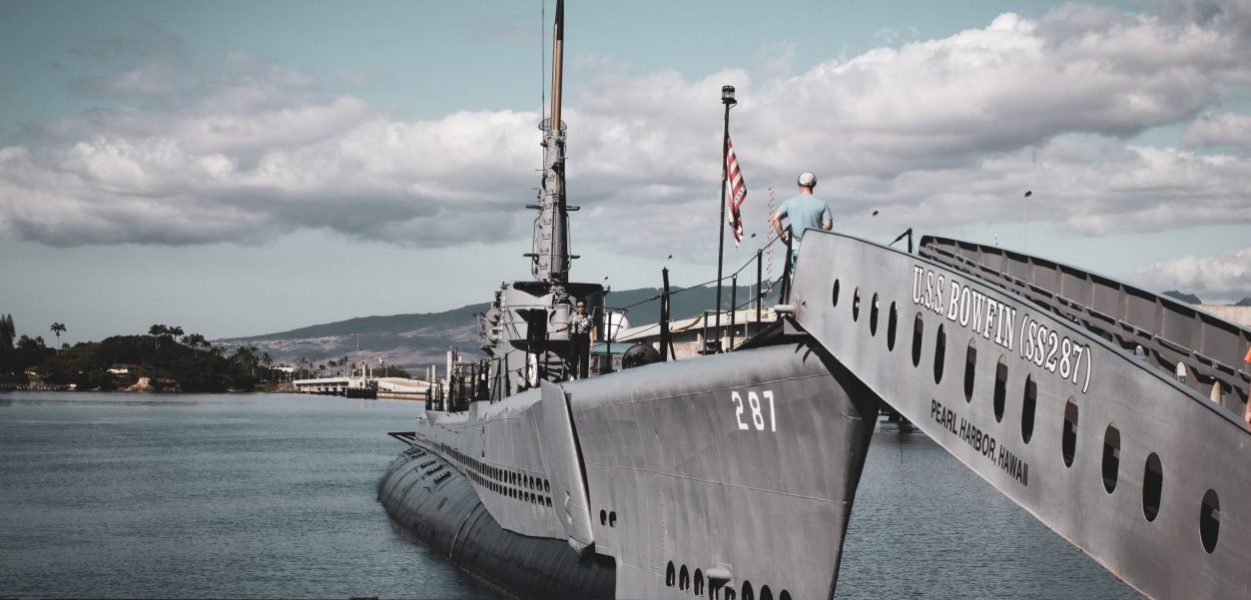The Year of Peril
Tracy Campbell—
As 1943 dawned, the relentless fear that had gripped the nation since Pearl Harbor had somewhat lessened, and although most understood that the most difficult days of the war still lay ahead, many worst-case scenarios had been avoided. There were no additional Pearl Harbors, economic chaos was averted, and democratic forms of constitutional government managed to endure. The year also displayed how a planned economy saved the nation from ruinous inflation and that government could work effectively to confront a grave crisis. In all, the nation had utilized vast economic and human resources and had made a national commitment to sacrifice life and treasure in what Franklin Roosevelt had termed “the most tremendous undertaking of our American history.”
After the searing heat of a crisis passes, often the original feelings of impending doom can be almost forgotten. The pervasive national anxiety of early 1942 would gradually be replaced by nostalgic and comforting memories of Americans confidently coming together, bound by their “righteous might” to build a vast arsenal that triumphed over enemies on two fronts.
That reassuring saga hides a more complicated story. Democracy had survived its most stringent test since the Civil War, but that outcome was far from assured. The nation’s fate would have been very different if Congress had challenged the president for ultimate war-making or budgetary authority. If attempts to control inflation or raise taxes had been crushed, the resulting economic disaster might have made the “Arsenal of Democracy” little more than a rhetorical flourish. If more attacks had occurred in the U.S., civil liberties might have eroded even further. If the Germans had been victorious at Stalingrad, the resulting military and diplomatic scenarios would have been harrowing. Observers who warned of dire consequences did so for good reason.
If an inept politician or demagogue had been in the White House, constitutional government would have been in jeopardy. Not that FDR was always fastidious about preserving constitutional norms. He was sometimes accused of using the crisis to seize dictatorial control, and he threatened Congress that he might assume new authority if he did not get his way on the anti-infl ation impasse. His administration established internment camps for Japanese Americans, maintained strict segregation in the armed forces, and intruded into the economic affairs of citizens more than any other president before or since. Yet Roosevelt did not use his popularity or three-term status to suspend the Constitution or impose martial law. He did not imprison his political opponents, and the election of 1942 went on as usual, with the president’s party losing many seats.
Democracy is essentially an act of faith, and national leaders mostly acted in good faith and did not exploit the war crisis for personal or partisan reasons. Leon Henderson and Donald Nelson were more focused on keeping inflation contained than concerned with their own careers. Many in Congress and the administration understood the peril that the nation faced and rose to the occasion. FDR was more interested in ensuring economic fairness and in making “Freedom from Want” an essential American principle than in becoming an autocrat. Still, if bigots such as Theodore Bilbo or Martin Dies had held more power, or if isolationists or opponents of government had won the day, the survival of democracy at home and abroad would not have been certain. The political and economic experience of America in 1942 demonstrates the fragile nature of self-government in times of national stress. As Steven Levitsky and Daniel Ziblatt write in How Democracies Die, “Would-be autocrats often use economic crises, natural disasters, and especially security threats—wars, armed insurgencies, or terrorist attacks— to justify antidemocratic measures.” Fortunately, that did not happen after Pearl Harbor, but not because it was somehow foreordained.
Despite the fact that the nation endured with its institutions and values intact, for millions of Americans in 1942 democracy was in short supply and the Constitution provided no safe haven. The treatment of Japanese Americans, the white supremacist efforts against African American equality in employment and housing, the racial riots at numerous military bases, the rising tide of anti-Semitism, the daily humiliations of Jim Crow policies in communities across the country, and the horrifi c episodes of lynchings all demonstrated that in times of national anxiety, we do not necessarily come together as one. Deep-seated hatreds are not put aside. They grow.
The trauma of Pearl Harbor and the fear that the nation might be invaded and conquered exposed America’s domestic paradoxes as nothing else could. They provided a rare opportunity to see what was possible when many economic and social structures were suspended and new ideas were debated. Some used the chance to dream of a more democratic society while others clung to old hatreds and suspicions. Historian John Hope Franklin, writing in the midst of the war, noted that two competing concepts deep within American life had long battled each other: “One tradition—that of democracy and liberalism—has built American civilization, while the other—that of narrowness and bigotry—has threatened to transform the great American dream into a nightmare.” “It is indeed a matter of survival,” he warned, “to see to it that the best of American traditions are not overwhelmed by the worst.” That war still rages.
From The Year of Peril by Tracy Campbell. Published by Yale University Press in 2020. Reproduced with permission.
Tracy Campbell is the E. Vernon Smith and Eloise C. Smith Professor of American History at the University of Kentucky. His previous books include The Gateway Arch: A Biography and Deliver the Vote: A History of Election Fraud, an American Political Tradition, 1742–2004.
Further Reading:



























